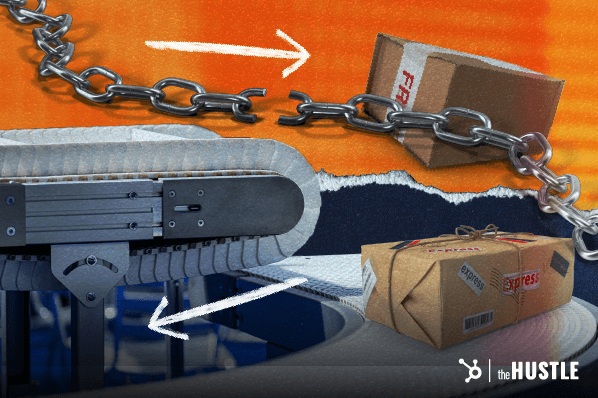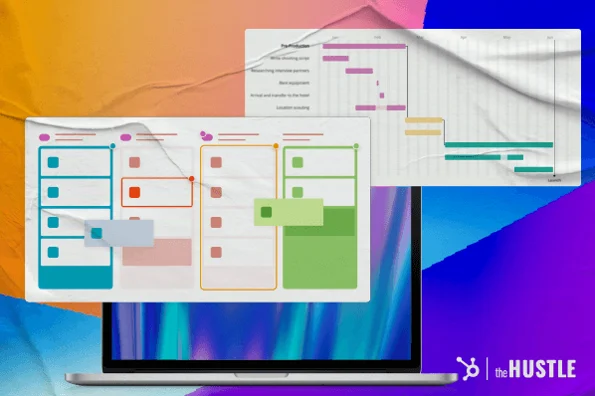Crafting new products takes time, preparation, and hard work. Even with a vision in mind, you still need to figure out the details of ideating, building, and launching your creation.

Having a product roadmap helps set up that much needed step-by-step process and paves the way for your company’s long-term success.
What Is a Product Roadmap?
A product roadmap is a visual that maps the vision, strategy, steps, and progress of a product or feature over time. It’s the foundation for building a product that explains the what, how, and why behind it.
A product roadmap typically comes after your team finishes crafting a compelling product vision — which explains the long-term mission and essence of your product, including target customers, differentiating factors, and more.

Free Product Go-to-Market Kit
Free templates to ensure that your whole team is aligned for your next product launch.
- Product Launch Template
- Product Roadmap Template
- Sales Plan Template
- And more!
Download Free
All fields are required.

A product roadmap brings together several parts of product development, including:
- Lanes: division of responsibilities (e.g., team assignments)
- Themes/Containers: high-level projects (e.g., working on third-party integrations)
- Bars: tasks to progress through within themes (e.g., creating an integration with Salesforce)
- Timeline: dates or time frames to finish objectives (e.g., between the months of January and April)
- Legends: visual cues explaining different purposes of the roadmap (e.g., color filters to show purpose of goals)
- Metrics: ways of measuring progress (e.g., percentage of phase II finished)
Putting it all together, your product roadmap will likely look something like this:
-1.png?width=650&height=476&name=01_%20Hustle%20Blog-%20Product%20Roadmap-72%20(1)-1.png)
Product Roadmap Types
The majority of product development roadmaps fall into two categories: Waterfall and Agile. Waterfall focuses on planning, whereas Agile emphasizes adaptability.
Waterfall Product Roadmap
The Waterfall methodology uses a sequential approach to product management. The team completes distinct steps before moving on to the next. Typically, Waterfall product development has specific dates when a phase needs to be finished. This roadmap might work best for teams that want to plan ahead.
Agile Product Roadmap
An Agile product roadmap is a flexible, sequential plan that maps out different phases of product development. Teams iterate and change the roadmap as they move through the process. Over 7 in 10 US companies use Agile over Waterfall.
An Agile strategy uses an interactive approach to building products. Instead of a rigid timeline, the strategy focuses on achieving objectives. An Agile product roadmap values adaptability and collaboration, allowing teams to stay flexible throughout product development.
Product Roadmap Example
Waterfall Roadmap Example
Waterfall works for companies that require long-term planning, such as construction. If a construction company has a project starting in quarter one, their product roadmap might look like the following:
-1.png?width=651&height=395&name=02_%20Hustle%20Blog-%20Product%20Roadmap-72-v2%20(1)-1.png)
In a Waterfall map, tasks occur one at a time instead of simultaneously. In the case of this company, they must acquire supplies before hiring crew, and so on.
Agile Roadmap Example
Software-as-a-service (SaaS) companies often use Agile product roadmaps because of their flexibility. They might run into critical hurdles while developing a product, such as having to fix major bugs or scrapping a feature. An Agile product roadmap for a SaaS company might look like this:
-1.png?width=651&height=395&name=03_%20Hustle%20Blog-%20Product%20Roadmap-72-v2%20(1)-1.png)
Compared to the Waterfall example, this one features overlapping initiatives. Instead of waiting to finalize interviews before increasing app performance, this team starts on the app before the interviews are finished. And if upgrading the homepage takes longer than expected, the team can still be on schedule for finalizing third-party integrations.
In these cases, different teams often have different assignments — making it possible for several things to happen at once.
How To Build a Product Roadmap
- Define Your Product Vision and Strategy
- Collaborate With Other Stakeholders
- Determine Features To Prioritize
- Map Out Different Initiatives Into Phases
- Pick a Template That Works for You
- Iterate and Optimize
1. Define Your Product Vision and Strategy
Figure out the why and how behind your product before crafting a product roadmap. They act as the foundation for product development, so prepare your product vision and strategy before moving into product roadmaps.
2. Collaborate With Other Stakeholders
When creating a product roadmap, ask other teams and departments for their input. What features do they feel customers will value most, based on their market research, vision, and strategy? How long does each team need to complete their tasks? What resources do they need to succeed?
3. Determine Features To Prioritize
Your product cannot have every bell and whistle. Using company research and user feedback, create a ranked list of features the team should prioritize. For example, if you find that ease of use matters greatly to customers, you may want to create a phase dedicated to improving your product’s responsiveness and user experience.
To improve this part of product roadmapping, you could map user stories — an engaging activity where all stakeholders are involved in identifying features important to customers.
For example, when figuring out how a user will achieve the goal of finding the product, you map out the steps a user will take to find it. This could be browsing through your company homepage, filtering through them, and landing on the new product page. Then, you can figure out if you can reduce any friction points your customer might run into along the way.
4. Map Out Different Initiatives Into Phases
Once you have a set of features and their priorities, convert that into different phases on your roadmap. Here, you address the when behind your product. What features will you work on first? How long will they take to complete? How does this project fit into the work of other teams?
5. Pick a Template That Works for You
Although you could create a roadmap using graphic software, templates can make your life easier. Below, you can find a selection of product roadmap templates to get started.
6. Iterate and Optimize
The process of product management does not fall under a linear progression. So, stay agile. Update the product roadmap as you go. If something major happens in the market (e.g., a new federal regulation), you may want to modify certain features.

Free Product Go-to-Market Kit
Free templates to ensure that your whole team is aligned for your next product launch.
- Product Launch Template
- Product Roadmap Template
- Sales Plan Template
- And more!
Download Free
All fields are required.

How To Manage a Product Roadmap
Measure Frequently
Product roadmaps have metrics attached to them — so make it a habit to regularly measure progress. For example, you could look at high-level metrics — such as percentage completed — or more specific ones, such as steps completed in subtasks.
Collaborate With Stakeholders
Ask teams how they feel about their work. Speak with developers, engineers, and anyone involved with building out the product. For example, you might want to schedule biweekly meetings to chat with relevant stakeholders. You could also send out regular emails explaining your organization’s progress, updates, and any changes to the product roadmap.
Make Changes When Needed
You might have the perfect product roadmap to start. But to manage one effectively, you need to make changes when necessary.
For example, a team might run into staffing issues — delaying an initiative on your roadmap. You want to review the product roadmap with this in mind. Ask yourself often which parts of the product roadmap seem volatile. Be prepared to change them if needed.
Product Roadmap Templates
Paid options, such as Coda, Trello, or Asana, can help you create product roadmaps you can easily share. But free options can work just as well.
- HubSpot’s product roadmap: features five other product marketing templates, including a product launch planner, product email templates, and more.
- Multiple product roadmap: enables the mapping of multiple products simultaneously.
- Agile product roadmap: helps teams map out specific tasks, including subsections and subtasks.
- Coda’s product roadmap template: Track statuses, communicate your plans and align team expectations in one place. No need to update multiple spreadsheets, or wonder if you’re looking at stale data.
- Goal-based product roadmap: centers the roadmap around objectives.
- Product release roadmap: features different phases of product releases, including alpha, beta, and more.
- Project roadmap: focuses more on deadlines versus product goals.










